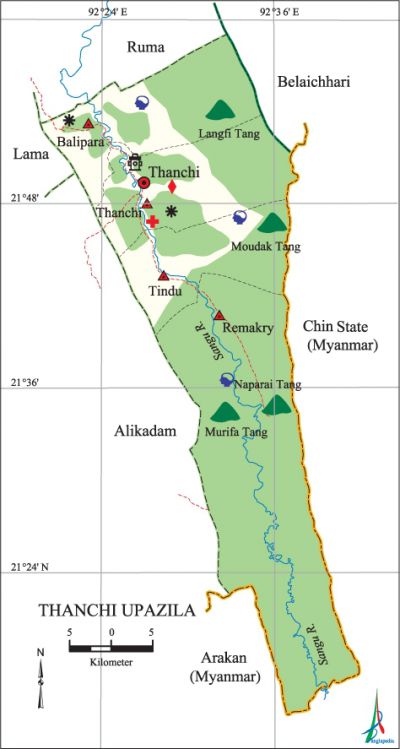Thanchi Upazila
Thanchi Upazila (bandarban district) area 1020.82 sq km, located in between 21°15' and 21°57' north latitudes and in between 92°20' and 92°41' east longitudes. It is bounded by ruma upazila on the north, arakan state of Myanmar on the south, Chin state of Myanmar and belaichhari upazila on the east, alikadam and lama upazilas on the west.
Population Total 23591; male 12344, female 11247; Muslim 1496, Hindu 387, Buddhist 11300, Christian 8577 and others 1831. Indigenous communities such as marma, Murong, tripura and khyang belong to this upazila.
Water bodies Main river: sangu (Shankha).
Administration Thanchi Thana was formed in 1976 and it was turned into an upazila in 1985.
| Upazila | ||||||||
| Municipality | Union | Mouza | Village | Population | Density (per sq km) | Literacy rate (%) | ||
| Urban | Rural | Urban | Rural | |||||
| - | 4 | 11 | 178 | 1778 | 21813 | 23 | 22.4 | 27.3 |
| Upazila Town | |||||
|
Area (sq km) |
Mouza |
Population |
Density (per sq km) |
Literacy rate (%) | |
| 21.08 | 1 | 1778 | 84 | 22.4 | |
| Union | ||||
| Name of union and GO code | Area (acre) | Population | Literacy rate (%) | |
| Male | Female | |||
| Tindu 76 | 112640 | 2227 | 2182 | 18.3 |
| Thanchi 57 | 69210 | 4102 | 3497 | 34.1 |
| Balipara 19 | 15360 | 2927 | 2537 | 38.7 |
| Remakry 38 | 24320 | 3088 | 3031 | 12.2 |
Source Bangladesh Population Census 2011, Bangladesh Bureau of Statistics.

Historical events The Burma-British War of 1824 resulted in inclusion of Arakan as one of the provinces of British India. This had eased the migration of the Arakanese to Thanchi and its neighbouring areas. The migrants later became permanent settlers in the area and were recognised as residents by Regulation-1 of 1900, popularly known as the Chittagong Hill Tracts Manual.
War of Liberation Freedom fighters did not have any direct encounter with Pakistani soldiers in Thanchi upazila but they did carry out a number of operations against the razakars and the local Shanti bahini. In May 1971, a troop of freedom fighters moved to Ruma through Rowangchhari and attacked razakars and members of peace committee and Albadr groups while they were in a meeting at Ruma. The group of miscreants fled and the freedom fighters had captured their arms.
For details: see থানচি উপজেলা, বাংলাদেশ মুক্তিযুদ্ধ জ্ঞানকোষ (Encyclopedia of Bangladesh War of Liberation), বাংলাদেশ এশিয়াটিক সোসাইটি, ঢাকা ২০২০, খণ্ড ৪।
Religious institutions Mosque 2, temple 2, church 75, math 1, keyang 27.
Literacy rate and educational institutions Average literacy 26.9%; male 33.9%, female 19.2%. Educational institutions: secondary school 3, primary school 16, community school 2. Noted educational institutions: Thanchi High School, Thanchi Bazar Model Government Primary School, Thanchi Headman Para Government Primary School.
Cultural organisations Library 2, community centre 3, auditorium 1, jatra party 9, women organisation 35, playground 2.
Tourist spots Langfi Tang Hill, Moudak Tang Hill, Naparai Tang hill, Murifa Tang Hill and Dim Hill are notable.
Main sources of income Agriculture 72.10%, non-agricultural labourer 1.48%, commerce 3.91%, service 2.49%, religious service 0.12% and others 19.90%.
Ownership of agricultural land Landowner 15.08%, landless 84.92%; agricultural landowner: urban 19.18% and rural 14.36%.
Main crops Paddy, sesame, turmeric, maize, potato, ginger, vegetables.
Main fruits Banana, jackfruit, orange, cashew nut.
Communication facilities Roads: pucca 4.76 km, mud road 119 km; waterway 40 km.
Hats, bazars and fairs Thanchi Bazar, Bara Madag Bazar, Chotto Madag Bazar, Bali Bazar, Tindu Bazar and Remakry Bazar are notable.
Main exports Turmeric, ginger, cane, bamboo, wood.
Access to electricity All the unions of the upazila are under rural electrification net-work. However 14.7% of the dwelling households have access to electricity.
Natural resources Bamboo, cane, wood, stone.
Sources of drinking water Tube-well 6.7%, tap 11.7% and others 81.6%.
Sanitation 5.1% of dwelling households of the upazila use sanitary latrines and 16.6% of dwelling households use non-sanitary latrines; 78.3% of households do not have latrine facilities.
Health centres Upazila health complex 1, family planning centre 1, community clinic 3, veterinary hospital 2.
NGO activities Operationally important NGOs are brac, caritas, UNDP. [Atikur Rahman]
References Bangladesh Population Census 2001 and 2011, Bangladesh Bureau of Statistics; Cultural survey report of Thanchi Upazila 2007.
